After a ring-a-ding-ding tour starting at the New York Public Library and swinging through the Grammy Museum at L.A. Live, a sweeping, multimedia exhibit exploring the life and career of Frank Sinatra has jetted into Miami, Florida.
Ol’ Blue Eyes had a big life: known first and foremost as a singer and actor and leader of the Rat Pack, he was also a painter (!), record label owner, producer, golfer, husband, and father. The exhibit, “Sinatra: An American Icon,” on view through June 5, 2016 at the HistoryMiami Museum, was organized to mark his 100th birthday and traces his path, and impact, from humble origins in Hoboken, N.J., through superstardom.
.
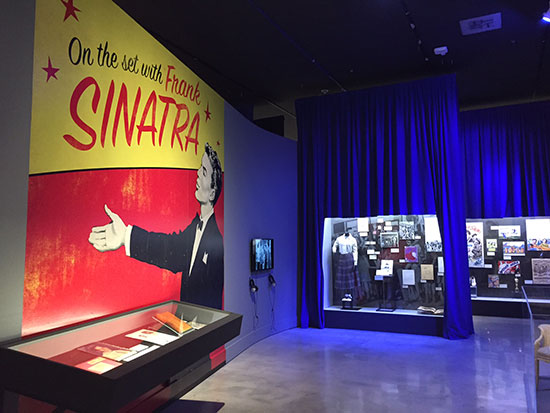
"Sinatra: An American Icon."
.
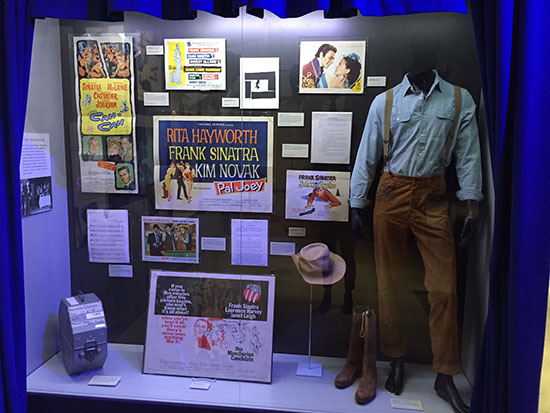
Memorabilia Installation at "Sinatra: An American Icon."
.
While they’re in the neighborhood, visitors to the Sinatra exhibit should walk across the plaza to Miami’s Main Library to check out the powerful commissioned paintings by Ed Ruscha that are permanently installed there.
The Sinatra exhibit at HistoryMiami chronicles the meteoric rise of the legendary crooner’s music career, his Hollywood success, his personal life, and humanitarian work. It’s clear the Sinatra family is heavily involved as the memorabilia includes rare original photos, family mementos like letters and correspondence, personal items of clothing from sharp tuxedos to embroidered pajamas and golf outfits—dig the mink golf bag—amateurish, self-taught artwork from his studio, and his awards: an Oscar, Golden Globe and Grammys.
Digging deep into the sprawling exhibit yields some secret, or at least little-known “art”-ifacts.
In the 1950s, after winning an Academy Award for Best Supporting Actor in “From Here to Eternity” and gaining some major recording clout, Sinatra was a year away from launching his own record label, Reprise Records. In 1959 he won his first Grammy, not for singing but for best album cover, on the album “Frank Sinatra Sings for Only the Lonely.”
.
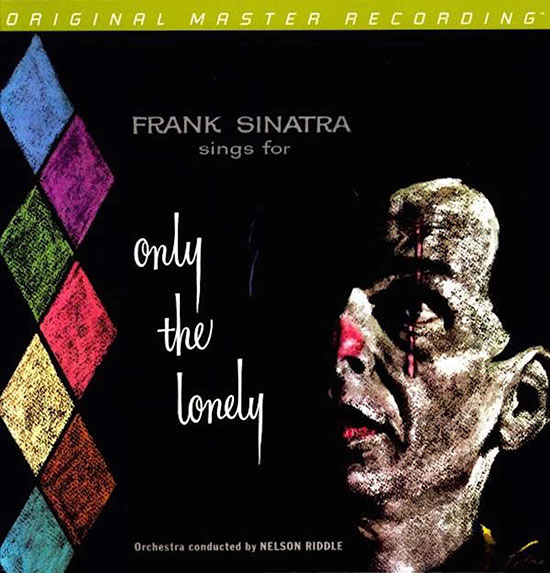
“Frank Sinatra Sings for Only the Lonely” cover.
.
This was the first time the category was honored. It was meant to be an award given to the art director, not the performer—unless it was both, as in this case.
The cover is an odd one for Sinatra, commissioned and painted by Nicholas Volpe, an illustrator artist who had been hired by the Academy Awards Committee to paint every Oscar winner, Sinatra included. The album cover painting features Sinatra as a sullen, Pagliacci-like painted clown with circus colored diamonds running up and down the left side of the cover. Sketched on the album's back cover is one of Sinatra's recurrent visual motifs: a lamppost.
The moody art fits the album, which is heavy on torch songs. At the time of the recording, Sinatra's divorce from raven haired actress Ava Gardner had been finalized, and Nelson Riddle (who created the arrangements for the album) had recently suffered the deaths of his mother and daughter, so the studio mood had to have been gloomy.
The award-winning album cover is not unique. Other covers from the same period feature similar shapes, colors and themes. Diamonds and jazzy squiggles show up here and there, and even odd graphic renderings of hats pop up on performers’ heads.
Deeper into the exhibit is a mockup of an art studio with some of Sinatra’s paintings on display. For Ol’ Blue Eyes, painting was a self-taught hobby he apparently did just for fun and to relax. He never exhibited the work and reportedly gave most of it away to family and friends. This was probably a good thing, as the paintings don’t hold up well to critical scrutiny. Compositions range from flat white backgrounds with colored circles and exploding star shapes to really silly clown paintings, probably done for his kids and grandkids.
Two of the paintings, one with an orange background populated with heavy geometric graphics and another of a black keyhole, show his influences, including a love of abstraction and suggestive shapes. He was on to something there, although with such a small selection it’s difficult to tell exactly what. But hey, Francis, probably better to stick with singing and acting.
.
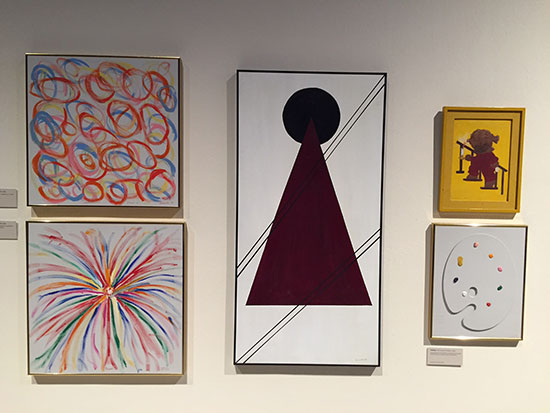
Artwork by Frank Sinatra.
.
His early years are presented in an intriguing way, with a replica of a bus in his hometown of Hoboken that has video monitors in the windows showing black and white street scenes passing by. Young, big-eared, skinny Francis routinely rode on that bus to recording studios and rehearsal halls, scrounging for work in a hardscrabble era. The stardom he would eventually find was probably beyond his wildest dreams.
Some great original drawings by caricaturist Al Hirschfeld are a highlight; as are black and white prints by photographer Herman Leonard of Sinatra in the studio. These are some of the best photos ever taken of him, and really capture his magnetism.
.
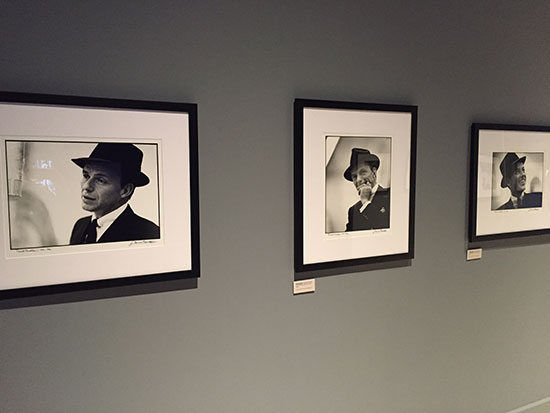
Photographs by Herman Leonard.
.
In addition to the traveling show, the HistoryMiami exhibit has its own curated special section to highlight Sinatra’s Miami connections, of which there were many. He filmed movies and TV shows here and performed at the fab deco resort The Fontainebleu, alone and with Dean Martin, Sammy Davis Jr. and other members of the Rat Pack.
.

Miami movie poster.
.

Rat Pack at the Fontainbleu.
.
Round screens on one wall project loops from some of the films, shows, and candid home movies made in Miami. A glass case is filled with show programs, tickets, and movie memorabilia.
.
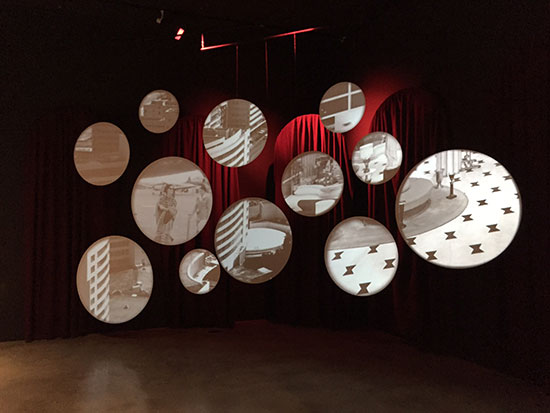
Screens at "Sinatra: An American Icon."
.
HistoryMiami Museum is a fortress that takes up a whole block in downtown Miami. The museum is located in a plaza with the Miami Main Library, which is well worth a visit to see the gorgeous collection of commissioned Ed Ruscha paintings from 1985-1989.
According to the artist’s bio on the website of Gagosian Gallery, which represents him, Ed Ruscha’s photography, drawing, painting, and artist books “record the shifting emblems of American life in the last half century ... Ruscha’s wry choice of words and phrases, which feature heavily in his work, draw upon the moments of incidental ambiguity implicit in the interplay between the linguistic signifier and the concept signified.”
Erected for the Miami Main Library’s 1985 opening, eight 16-foot-long Ruscha panels were mounted around the lobby’s soaring rotunda, tied together by the artist with a line from Shakespeare: “Words Without Thoughts Never to Heaven Go.” The words, taken from “Hamlet,” are on separate panels against a sky-like ground, installed in a continuous frieze.
.
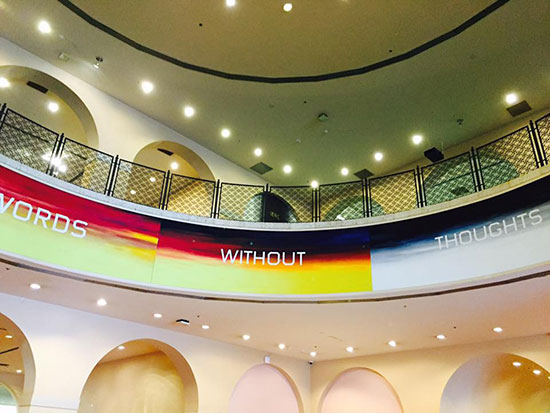
“Words Without Thoughts Never To Heaven Go” by Ed Ruscha. 7 painted panels in a 360 degree mural.
.
In a second phase of the commission, Ruscha painted related lunettes—so named for the half-moon shape of the spaces they inhabit—for installation in 56 of the 140 blind arches built in to the library's two floors.
The painted backgrounds of the lunettes are black, white and gray, creating a unifying theme reflecting the spirit of black ink printed on white paper. These works contain provocative and whimsical bits of verbiage in both English and Spanish, serving to stimulate thoughts on the nature of language.
______________________________
BASIC FACTS: “Sinatra: An American Icon” is on view March 4 through June 5, 2016 at HistoryMiami Museum, 101 West Flagler Street, Miami, FL 33130 and Miami Main Library, 101 W Flagler St, Miami, FL 33130. www.historymiami.org.
______________________________
Copyright 2016 Hamptons Art Hub LLC. All rights reserved.

Sinatra not w/Rat Pack. Just a few associates & a coupla bodyguards.